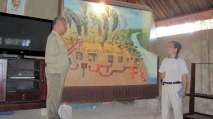
The Cu Chi tunnel complex, an underground web of impossibly-small, cramped and very-well-hidden tunnels and villages, is one of many testaments to the ingenuity of the Vietnamese people, who had been the victims of invading warriors for many hundreds of years, up until the end of the Vietnam-America war in 1975.
Digging began in 1948 for the guerrillas to hide from French air and ground sweeps, and continued through the 50s and 60s during the American invasion. Using tiny hand tools to continuously scrape away dirt, and small woven buckets to carry the dirt out, the tunnels were used for communication routes, food and weapons caches, hospitals and living quarters for guerrilla fighters.
In the video, you'll see a former Vietnamese veteran who lived in the tunnels during the war. You'll notice he is missing one arm -- which he lost in the war. He also lost an eye in the war. As part of his overview of the tunnel phenomenon, he explained what it was like to live in these subterraneous hamlets where lack of air, food and water made life nearly unbearable. At the end of his presentation, speaking as a veteran and on behalf of a people who have been near-continuously invaded by outsiders for hundreds of years, this gentleman poignantly emphasized the desire of the Vietnamese people for no more war, and a deep hope for peace among mankind.
As we walked the grounds we saw examples of the weapons and deadly booby traps of all kinds that were used by the Vietnamese. We also had the chance to climb down into the tunnels. The video shows our endurance athlete, Sara Miller -- despite the extreme heat and humidity -- trying to enter a tunnel via a well-hidden trap door she'd discovered a few minutes before.